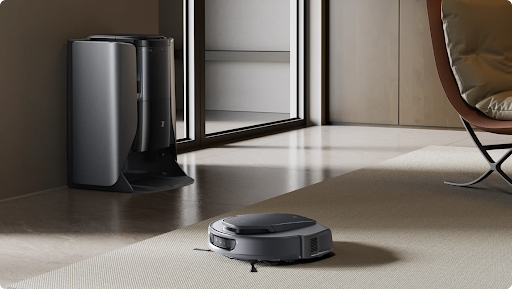In the world of home cleaning, mop robots have gained tremendous popularity due to their convenience and efficiency. However, not all mop robots are created equal. Two main types dominate the market: wet mop robots and dry mop robots. While both serve the purpose of cleaning floors, they each have unique features that make them better suited for different cleaning needs. In this article, we’ll compare the two, helping you decide which type of mop robot is best for your home.
Wet Mop Robots
Wet mop robots are designed for deep cleaning. They feature a water tank that allows them to wet mop floors, making them ideal for removing sticky stains and stubborn dirt.
These robots often come with larger water tanks than dry models, allowing them to clean for longer periods without needing a refill. Many wet mop robots include features like automatic water release, ensuring the mop head stays damp throughout the cleaning session.
Wet mop robots are perfect for tackling dirt that a dry mop may leave behind. Their ability to wet the floor makes them effective for tough stains and sticky spills. Most models allow you to adjust the water flow and cleaning intensity for different floor types.
While they clean larger areas without needing to refill, once the water runs out, the cleaning stops. Wet mop robots are highly effective, especially in homes with pets or children, where messes are more frequent.
Dry Mop Robots
Dry mop robots are designed for light dusting and quick cleaning. Unlike wet models, they use dry microfiber cloths to pick up dust, hair, and dirt.
These robots rely on rotating microfiber pads that trap dust and debris. Since they don’t require water, they’re ideal for light, daily maintenance. Many come with adjustable speed settings but focus mainly on surface dirt rather than deep cleaning.
Dry mop robots are great for homes that need daily dusting but don’t experience frequent spills or stains. They’re particularly useful on hardwood floors, where water damage is a concern.
These robots excel in high-traffic areas, such as entryways and hallways, quickly picking up dirt and hair to maintain a clean environment. They are fast, efficient, and require minimal maintenance, making them perfect for quick daily touch-ups.
Which Type Is Best for Different Floor Types?
Choosing between a wet or dry mop robot depends on your floor type and cleaning needs. Here’s a comparison based on common floor materials:
- Hardwood Floors:
Wet mop robots are usually not recommended for hardwood floors because excess moisture can cause the wood to warp or swell. Dry mop robots, on the other hand, are perfect for regular dusting and can be safely used on hardwood surfaces without risking damage. - Tile or Vinyl Floors:
Wet mop robots work exceptionally well on tile and vinyl floors. These surfaces can handle moisture, and the wet mop robot’s ability to clean grout lines and stubborn stains makes it ideal for these floor types. - Carpet:
Dry mop robots can help remove surface dirt from low-pile carpet, but they are generally ineffective on high-pile carpet. Wet mop robots are not designed for carpet cleaning, and using them on carpets could cause damage. For carpeted areas, a robot vacuum for carpet is usually a more suitable option. Robot vacuums are specifically designed with strong suction and brushes to clean deep into carpet fibers, making them much more effective for carpet cleaning than mop robots. - Laminate Floors:
Like hardwood, laminate floors are best suited for dry mopping, as water can damage the surface. Dry mop robots will keep the laminate floors clean and dust-free without the risk of moisture damage.
Performance and Coverage: Wet vs. Dry
When it comes to performance, wet mop robots offer more intensive cleaning due to their ability to remove stuck-on dirt and stains. However, they also take more time to clean the same area because they require drying and water refills.
Dry mop robots, in contrast, are faster but may leave some debris behind, especially if it’s stuck to the surface. They are more suited for light, daily cleaning, making them ideal for maintaining cleanliness without the need for frequent deep cleaning.
The coverage area for both types of mop robots depends on the water or dust capacity, battery life, and design of the robot. Wet mop robots can cover larger areas without needing to be refilled, but once the water runs out, they need a refill to continue cleaning. Dry mop robots are quicker but might need frequent cleaning of the microfiber cloth to ensure efficient dirt collection.
Price Range and Affordability
Generally speaking, wet mop robots tend to be more expensive than dry mop robots because of their additional features, such as water tanks and mopping capabilities. Wet mop robots often come with more advanced sensors, water control systems, and multi-functional features, which contribute to their higher cost.
Dry mop robots, however, are typically more affordable and still offer excellent value for light cleaning tasks. They are ideal for those on a budget or those who only need a robot for quick, daily cleaning.
Conclusion
Deciding between a wet and dry mop robot depends on your cleaning needs, floor types, and budget. If you have stubborn stains, tile floors, or need deep cleaning, a wet mop robot is the better choice. However, if you’re looking for a convenient, low-maintenance solution for daily dusting and upkeep, a dry mop robot will serve you well. Consider your priorities—whether it’s performance, speed, or ease of use—to choose the best mop robot for your home.



